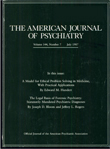Accelerometric assessment of tardive dyskinesia
Abstract
Accelerometric measures associated with resting the hand, posturing the arm, and moving the arm were taken in 10 patients with tardive dyskinesia and eight schizophrenic patients matched for diagnosis, age, sex, likelihood of medication to induce extrapyramidal symptoms, and chlorpromazine-equivalent dose. A multivariate analysis of variance and follow-up univariate analyses revealed that the tardive dyskinesia patients showed 1) greater amplitude of dyskinetic movements, 2) lower peak frequency of dyskinetic movements, and 3) more spikes-points beyond four standard deviations from the mean. Multiple discriminant analyses revealed that all patients were correctly classified as to presence or absence of tardive dyskinesia.
Access content
To read the fulltext, please use one of the options below to sign in or purchase access.- Personal login
- Institutional Login
- Sign in via OpenAthens
- Register for access
-
Please login/register if you wish to pair your device and check access availability.
Not a subscriber?
PsychiatryOnline subscription options offer access to the DSM-5 library, books, journals, CME, and patient resources. This all-in-one virtual library provides psychiatrists and mental health professionals with key resources for diagnosis, treatment, research, and professional development.
Need more help? PsychiatryOnline Customer Service may be reached by emailing [email protected] or by calling 800-368-5777 (in the U.S.) or 703-907-7322 (outside the U.S.).



